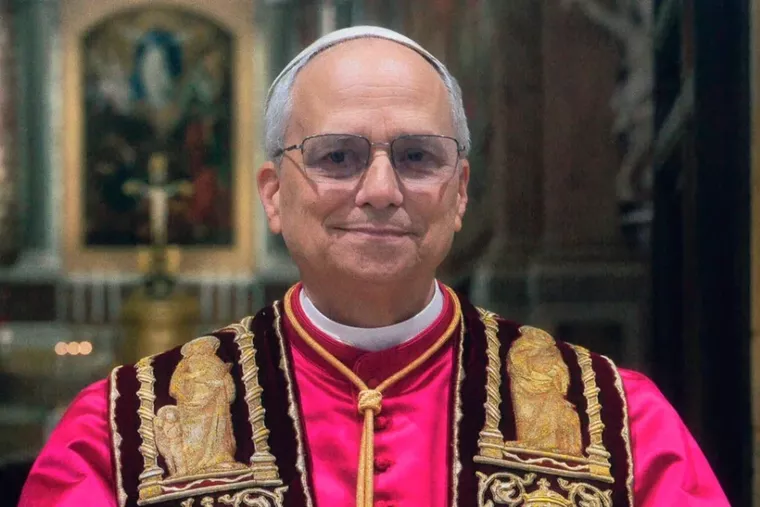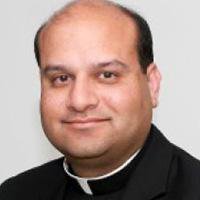
COMMENTARY: It’s worth noting that the Pauline Chapel, one of three in the Apostolic Palace, is pictured in the Holy Father’s official portrait. The personal chapel of the Holy Father is the official place for the pope’s prayers and Masses.
SIGN UP FOR OUR NEWSLETTER HERE
The official portrait of Pope Leo XIV, soon to adorn hundreds of thousands of Catholic churches, chanceries, parish offices, rectories, schools, chaplaincies and hospitals, is doubly significant.
In addition to the new Holy Father in the foreground, the background is the Pauline Chapel in the Apostolic Palace.
Perhaps the new papal portrait might attract more attention to this important part of ecclesial and artistic patrimony. The Pauline Chapel includes the last frescoes of Michelangelo, painted as an old man after he had finished the Last Judgment in the Sistine Chapel.
There are three papal chapels in the Apostolic Palace. The Sistine Chapel is the most famous. The Pauline Chapel is just a few steps away from the Sistine across the Sala Regia. The third is the Redemptoris Mater Chapel, where not only the annual Lenten retreat for the Holy Father and the Roman Curia was preached, but also the Advent and Lent meditations by the papal preacher. Pope Francis moved those events elsewhere early on, so the Redemptoris Mater has fallen into disuse.
The Sistine Chapel takes its name from Pope Sixtus IV, who had it built. It is dedicated to the Blessed Mother. The Pauline Chapel takes its name from Pope Paul III and is dedicated to the apostles Peter and Paul.
The Pauline Chapel is the personal chapel of the Holy Father. Smaller than the Sistine — and not thronged by pilgrims and tourists — it is the official place for the pope’s prayers and Masses.
Practically speaking, because there is a small chapel in the third-floor private apartment of the Holy Father, the Pauline is not used by the pope that often. Sts. Paul VI and John Paul II, and Pope Benedict XVI, offered daily Mass in the private upstairs chapel; Pope Francis used the chapel in the St. Martha guesthouse, where he lived. The Pauline Chapel, though, retains its official status as the privileged chapel for the Holy Father’s prayer and worship.
The Pauline Chapel figured prominently in the recent conclave. The cardinals gathered there before processing into the Sistine Chapel to take their oaths. The daily morning Mass of the cardinals was there — though that was only one day, as the conclave voting took less than 24 hours.
As the Pauline Chapel is the personal chapel of the pope, immediately upon leaving the Sistine Chapel, Pope Leo XIV was taken there to pray privately. His official portrait is the photograph taken of him at the threshold of the chapel upon his exit. It bears noting that he chose that photo, given that there are literally thousands of photographs of Leo from the first days alone.
In the original vision that Pope Julius II had for the decoration of the Sistine Chapel, the ceiling was intended to feature the 12 Apostles — a suitable theme for a papal chapel in the Apostolic Palace. Michelangelo went in a different direction with the ceiling, featuring the early chapters of Genesis, and the ceiling took on the cosmic dimension of creation.
When the Last Judgment was added years later, Michelangelo’s Sistine Chapel presented creation and judgment, the beginning and the end. There is almost no reference to the apostles. There is one Petrine image, The Consignment of the Keys, by Perugino on a lateral wall, which was featured heavily in images of the conclave.
The Pauline Chapel is the chapel of Sts. Peter and Paul, the princes of the apostles who consecrated Rome with their martyrdoms. On the first full day of Leo XIV’s pontificate he celebrated Mass with the cardinals in the Sistine Chapel, but got ready in the Pauline Chapel, which features a large Michelangelo fresco of the conversion of Saul on the road to Damascus. That was the assigned lectionary reading for that day (though different readings were used for the papal Mass with the cardinals). It is possible that those moments suggested to Pope Leo XIV that the Pauline Chapel would be a suitable choice of setting for his papal portrait.
The Pauline Chapel is noted for the twin frescoes of Michelangelo — the conversion of Paul and the crucifixion of Peter — on the lateral walls. They were his last works, completed in old age and poor health, when his principal preoccupation was designing the immense cupola of St. Peter’s — one of the great architectural and engineering marvels of the period.
In 1994, John Paul delivered a famous homily upon the completion of the restoration of the Sistine Chapel frescoes, boldly declaring that “the Sistine Chapel is precisely the sanctuary of the theology of the human body.”
Similarly, after a restoration of the Pauline Chapel in 2009, Pope Benedict XVI delivered a masterful homily on Michelangelo’s work, noting the depiction of the faces of Paul and Peter.
“Why is Paul portrayed with such an elderly face?” Benedict asked. “It is the face of an old man, whereas we know and Michelangelo also knew that the calling of Saul on the road to Damascus occurred when he was about 30 years old. … The face of Saul-Paul, which is that of the artist himself, who by then was old, troubled and in search of the light of truth, represents the human being in need of a greater light. … Therefore, in Paul’s face we can already perceive the heart of the spiritual message of this chapel: the wonder of Christ’s grace which transforms and renews mankind through the light of his truth and his love.”
That passage treats Michelangelo not only as the great artist of his day, but also a man of deeply biblical spirituality.
“Peter’s face, too, surprises us,” continued Benedict. “Here the age represented is the correct one, but it is the expression that amazes and questions us. Why this expression? It is not an image of suffering, and Peter’s body communicates a surprising degree of physical vigor. The face, especially the forehead and eyes, seems to express the state of mind of a man confronting death and evil. There is a bewilderment, a sharp, projected gaze that seems almost to search for something or someone in the final hour. … If one comes to this chapel to meditate, one cannot escape the radicalism of the question posed by the cross: the Cross of Christ, Head of the Church, and the cross of Peter, his Vicar on earth.”
The Pauline Chapel was built and decorated precisely to be a place where the popes could come to meditate, their prayer shaped by Michelangelo’s spiritual imagination. And as the sublime frescoist placed himself in the scenes of Peter and Paul, so too the Successor of Peter is invited to see himself in the same mission given to the city of Rome, the mission of Peter and Paul, patrons of the city of which he is the bishop.
The tradition of taking the new Holy Father to the Pauline Chapel to pray, even before he is presented to the city and the world from the balcony of St. Peter’s, indicates that the Pauline Chapel belongs to the work of the pontificate in a more profound way than the Sistine Chapel, which belongs more strictly to the election.
The Holy Father’s new portrait reminds us of that. As it is hung in many places in the days and weeks ahead, it ought to prompt Catholics to remember the “other chapel” of the papacy, the personal chapel of the new Pope and his predecessors.
This articles was originally published on NCRegister.
HOW TO SEE THE HOLY FATHER POPE LEO XIV: EWTN TRAVEL JUBILEE APP

Father Raymond J. de Souza is the founding editor of Convivium magazine.







